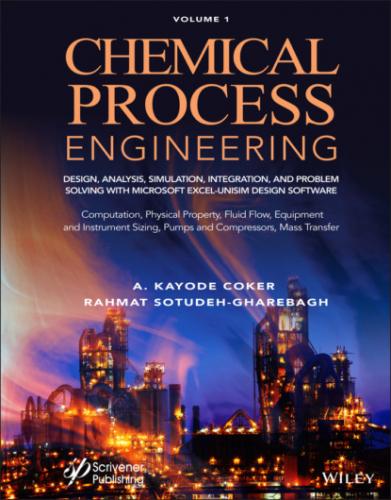15 7 Mass Transfer INTRODUCTION VAPOR LIQUID EQUILIBRIUM BUBBLE POINT CALCULATION DEW POINT CALCULATION EQUILIBRIUM FLASH COMPOSITION Nomenclature TOWER SIZING FOR VALVE TRAYS PACKED TOWER DESIGN DETERMINATION OF PLATES IN FRACTIONATING COLUMNS BY THE SMOKER EQUATIONS MULTICOMPONENT DISTRIBUTION AND MINIMUM TRAYS IN DISTILLATION COLUMNS EXAMPLES AND SOLUTIONS References
16 Index
List of Tables
1 Chapter 1Table 1.1 Selected basic functions of Excel spreadsheet [2, 5].Table 1.2 Selected applied functions of Excel spreadsheet for design and simulat...Table 1.3 Syntax for finding trendline coefficients [7].Table 1.4 Input data for liquid mixing experiment.Table 1.5 Input data for fluid flow experiments.Table 1.6 xy data for polynomial approximation.Table 1.7 Blend specifications.Table 1.8 Design and reaction data for continuous stirred tanks.Table 1.9 Flow gas data at various temperatures.Table 1.10 Kinetic and concentration data for the batch reactor.Table 1.11 Benefits of using process simulators for engineers and scientists.Table 1.12 List of mostly used chemical process simulators.Table 1.13 Good simulation practice.
2 Chapter 2Table 2.1 The temperature range for the surface tension.Table 2.2 Calculation of specific gravity of natural gas.
3 Chapter 3Table 3.1 Values of K1 and K∞ for the two-K method for pipe fittings. Source: H...Table 3.2 Excess head loss “K” correlation due to changes in pipe size [1].Table 3.3 Equivalent roughness of various surfaces (Source [6]).Table 3.4 Recommended fluid velocity and maximum ΔP for carbon steel vapor lines...Table 3.5 Approximate k values for some common gases (68°F, 14.7 psia).Table 3.6 Friction factors for total turbulence in new commercial steel pipes.Table 3.7 Characteristic linear Velocities of two-phase flow regimes.Table 3.8 Characteristic linear velocities of two-phase flow regimes [26].
4 Chapter 4Table 4.1 Design criteria for Reflux Distillate Accumulators.Table 4.2 Operator factors for external units.Table 4.3 Head blank diameter factor (H.Fac).Table 4.4 Effect of variables on Cyclone Performance.Table 4.5 Cyclone operational and design data.Table 4.6 Dryer operational data.
5 Chapter 5Table 5.1 Flow coefficients for control valves.Table 5.2 Correction factors for control valve flow coefficient.Table 5.3 Cv table for quick opening trim.Table 5.4 Cv table for linear trim.
6 Chapter 6Table 6.1 General types or classification of pumps.Table 6.2 Approximate capacity-head ranges for centrifugal pumps.Table 6.3 Effects of fluid density on head.Table 6.4 Basic parts of a centrifugal pump.Table 6.5 Pump selection guide.Table 6.6 Troubleshooting centrifugal pumps.Table 6.7 Pump installation check list [30].Table 6.8 General compression and vacuum limits.Table 6.9 Comparison of performance for propane.Table 6.10 Compressibility Factors, Z.Table 6.11 Approximate ratio of specific heats (“k” values) for various gases.Table 6.11a Constants for molal heat capacity.Table 6.12 Properties of the gas mixture.Table 6.13 Polytropic efficiencies for various types of machines.Table 6.14 Approximate mechanical losses as a percentage of a gas power requirem...Table 6.15 Properties of the gas mixture.Table 6.16 Probable causes of reciprocating compressor trouble.Table 6.17 Probable causes of centrifugal compressor trouble.
7 Chapter 7Table 7.1 Ways to produce two-phase mixture [1].Table 7.2 Equilibrium flash criteria.Table 7.3 Values of G and H for each tray spacing.Table 7.4 Recommended values for foam factor and residence time.Table 7.5 Tower diameter versus cross sectional areas.Table 7.6 Downcomer dimensions.Table 7.7 Downcomer dimensions.Table 7.8 Downcomer dimensions.Table 7.9 Tower diameter versus cross sectional areas.Table 7.10 Determining number of passes.Table 7.11 Pressure-drop correlations for packed towers. Source: van Winkle [17]...Table 7.12 Generalized pressure drop rules. Source: Branan [25].Table 7.13 Packing factors (Source: Eckert [26]).Table 7.14 Constants for each pressure drop correlation. Source: Blackwell [13].Table 7.15 Composition of feed.Table 7.16 Feed composition to a natural gas liquefaction plant.Table 7.17 Bubble and dew point temperatures.Table 7.18 Constants for each pressure drop correlation.
List of Illustrations
1 Chapter 1Figure 1.1 The Excel Goal Seek Window.Figure 1.2 The Excel Solver parameters Window.Figure 1.3 Snapshot of the Excel calculations.Figure 1.4 A characteristic curve of power number as a function of Reynolds numb...Figure 1.5 Snapshot of the Excel calculations for the fluid flow experiment.Figure 1.6 Snapshot of the Excel calculations for the LINEST function.Figure 1.7 Snapshot of the Excel spreadsheet calculations to determine the quant...Figure
